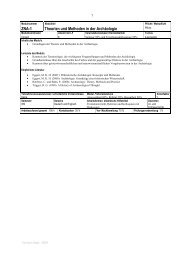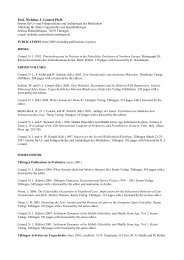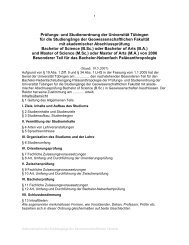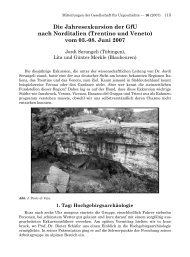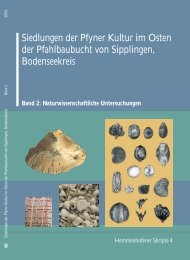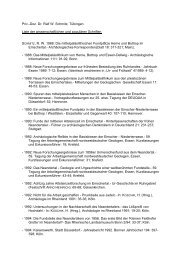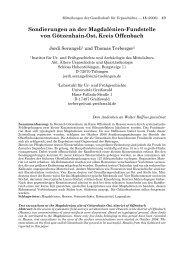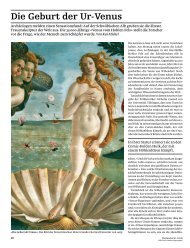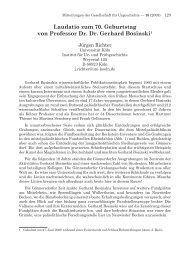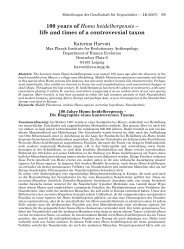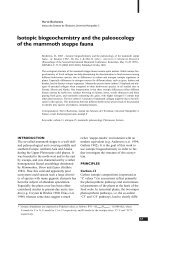bronze age environment and economy in the troad - Universität ...
bronze age environment and economy in the troad - Universität ...
bronze age environment and economy in the troad - Universität ...
You also want an ePaper? Increase the reach of your titles
YUMPU automatically turns print PDFs into web optimized ePapers that Google loves.
chapter 1: <strong>environment</strong> <strong>and</strong> archaeology<br />
1.2.2 Troy<br />
1.2.2.1 Chronology<br />
The dat<strong>in</strong>g of <strong>the</strong> different periods <strong>in</strong> Troy is one of <strong>the</strong> focal<br />
po<strong>in</strong>ts of chronological discussions. S<strong>in</strong>ce Blegen (1963)<br />
many, often divergent dates for <strong>the</strong> different phases have<br />
evolved (Korfmann <strong>and</strong> Kromer 1993). The results of <strong>the</strong> new<br />
excavations tend to an older dat<strong>in</strong>g.<br />
The match<strong>in</strong>g of <strong>the</strong> different periods of Troy with <strong>the</strong><br />
common terms of Early, Middle <strong>and</strong> Late Bronze Age, is part<br />
of <strong>the</strong> problem. While <strong>the</strong> traditional approach places,<br />
accord<strong>in</strong>g to differences <strong>in</strong> material culture, Troy I to Troy V<br />
under Early Bronze Age, <strong>the</strong> recent <strong>in</strong>vestigations put at least<br />
Troy IV <strong>and</strong> V <strong>in</strong> <strong>the</strong> Middle Bronze Age. In <strong>the</strong> meantime it<br />
has been suggested that <strong>the</strong>re is a chronological overlap<br />
between Troy I <strong>and</strong> Troy II, <strong>and</strong> radiocarbon dates show<br />
overlap also from o<strong>the</strong>r periods. A cultural break between Troy<br />
III <strong>and</strong> IV was also recognised. Recently Korfmann has<br />
matched <strong>the</strong> different periods from Troy with cultural<br />
def<strong>in</strong>itions (Korfmann 1996). Accord<strong>in</strong>g to him, Troy I-Troy<br />
III represent close relations to <strong>the</strong> coastal eastern<br />
Mediterranean region, Troy IV <strong>and</strong> Troy V show clear<br />
connections to Anatolian cultures <strong>and</strong> Troy VI <strong>and</strong> Troy VIIa<br />
represent a very advanced civilisation of Troy. In Troy VIIb he<br />
claims a ‛Troy-Culture’, determ<strong>in</strong>ed by Balkan <strong>in</strong>fluences.<br />
The archaeobotanical work concentrates on <strong>the</strong> periods Troy I<br />
until Troy VII. The later periods, i.e. <strong>the</strong> Greek-Hellenistic <strong>and</strong><br />
<strong>the</strong> Roman, were not part of <strong>the</strong> archaeobotanical research<br />
project, but will be mentioned from time to time <strong>in</strong> contrast<strong>in</strong>g<br />
<strong>the</strong> Bronze Age results with <strong>the</strong> whole settlement period. From<br />
<strong>the</strong> thickness <strong>and</strong> preservation of <strong>the</strong> archaeological layers, <strong>the</strong><br />
periods are not represented equally <strong>in</strong> <strong>the</strong> site <strong>and</strong> were not<br />
excavated to an equal degree. Therefore no samples were obta<strong>in</strong>ed<br />
from periods Troy III <strong>and</strong> Troy V. The rema<strong>in</strong><strong>in</strong>g periods<br />
(Troy I/II, Troy IV, Troy VI <strong>and</strong> Troy VII) are represented<br />
unequally <strong>in</strong> archaeobotanical samples for <strong>the</strong> same reasons.<br />
To deal with a relatively equal amount of samples for each<br />
time period <strong>and</strong> to have a sensible amount of samples for a<br />
statistical analysis, it was decided to group <strong>the</strong> samples for <strong>the</strong><br />
general view of <strong>the</strong> plant rema<strong>in</strong>s <strong>in</strong> <strong>the</strong> Bronze Age, i.e. Troy I<br />
<strong>and</strong> Troy II under Early Bronze Age Troy, Troy VI <strong>and</strong> VII<br />
under Late Bronze Age Troy. Middle Bronze Age Troy is<br />
represented almost exclusively by Troy IV samples. Because<br />
<strong>the</strong> samples from Archaic, Classical <strong>and</strong> Hellenistic period<br />
were not part of <strong>the</strong> question <strong>the</strong>y were summarised for <strong>the</strong><br />
data analysis as Post–Bronze AgeTroy.<br />
1.2.2.2 Archaeological research history <strong>and</strong><br />
results from <strong>the</strong> early excavations<br />
First mentioned <strong>in</strong> writ<strong>in</strong>g by Homer <strong>in</strong> <strong>the</strong> Iliad, <strong>the</strong> city of<br />
Troy has been under discussion s<strong>in</strong>ce antiquity. Interpretation<br />
of <strong>the</strong> Iliad, a research problem <strong>in</strong> its own right, was <strong>the</strong><br />
impetus for fur<strong>the</strong>r mythologis<strong>in</strong>g <strong>in</strong> later <strong>and</strong> historical time,<br />
<strong>and</strong> this rema<strong>in</strong>s <strong>the</strong> case (Latacz 1990). The myth of Troy, i.e.<br />
<strong>the</strong> fall of a wealthy <strong>and</strong> powerful city, might have been <strong>the</strong><br />
ma<strong>in</strong> impell<strong>in</strong>g force on Schliemann’s search for Troy <strong>and</strong> his<br />
first excavations (Schliemann 1881, 1884, 1890 und 1891).<br />
With four excavations (1871-1873, 1878-1879, 1882, 1890) he<br />
provided <strong>the</strong> basis for fur<strong>the</strong>r <strong>in</strong>vestigations, <strong>and</strong> dug out <strong>the</strong><br />
famous treasures. At that po<strong>in</strong>t he was not aware of <strong>the</strong> correct<br />
chronostratigraphy of <strong>the</strong> site. The Mycenaean Troy layers he<br />
was look<strong>in</strong>g for, because of <strong>the</strong>ir supposed equivalence with<br />
<strong>the</strong> Homeric Troy, were ma<strong>in</strong>ly excavated by his successor<br />
Dörpfeld from 1893, who also developed <strong>the</strong> chronostratigraphical<br />
system of Troy I to Troy IX (Dörpfeld 1902).<br />
Between 1932 <strong>and</strong> 1938 a team of American archaeologists<br />
excavated at Troy under <strong>the</strong> leadership of Blegen, who improved<br />
<strong>the</strong> chronology of <strong>the</strong> site (Blegen 1950a <strong>and</strong> 1963).<br />
What follows is a summary of <strong>the</strong> ma<strong>in</strong> results from <strong>the</strong>se early<br />
excavations, selected for <strong>the</strong>ir relevance to <strong>the</strong> archaeobotany.<br />
With <strong>the</strong> f<strong>in</strong>d of <strong>the</strong> fortification wall of Troy I (from c. 2920<br />
BC) Schliemann <strong>and</strong> Dörpfeld demonstrated that <strong>the</strong> site was<br />
of <strong>the</strong> ‛fortress’ type from its <strong>in</strong>ception. Blegen divided Troy I<br />
<strong>in</strong>to 10 (a-j) architectural phases. They will not be discussed,<br />
because, apart from <strong>the</strong> problem of chronological classification<br />
of <strong>the</strong> soil samples, it is not possible to apply a chronological<br />
system of 47 settlement phases to a sensible number of<br />
samples.<br />
The ma<strong>in</strong> architectural features <strong>in</strong> Troy I are large, freest<strong>and</strong><strong>in</strong>g<br />
houses, built of mudbrick on a stone socle, but no<br />
complete plans were recovered. The well-known ‛rectangular<br />
megaron’ or ‛house 102’ (where six <strong>in</strong>fant burials were discovered<br />
by <strong>the</strong> Blegen team) that is visible <strong>in</strong> <strong>the</strong> ‛Schliemann<br />
trench’ is one of <strong>the</strong> oldest build<strong>in</strong>gs <strong>in</strong> Troy. Typical pottery<br />
for <strong>the</strong> early phases is dark monochrome burnished ware.<br />
Later Aegean ceramic imports appear, <strong>in</strong>clud<strong>in</strong>g fragments of<br />
EH/EC II Urfirnis which show that <strong>the</strong> middle of Troy I overlaps<br />
<strong>in</strong> date with EH/EC II on <strong>the</strong> Greek Ma<strong>in</strong>l<strong>and</strong> <strong>and</strong> on <strong>the</strong><br />
central Aegean isl<strong>and</strong>s. At <strong>the</strong> end of Troy I, Aegean imports<br />
are recognisable by sauceboat fragments. Instruments of common<br />
h<strong>and</strong>crafts (needles, p<strong>in</strong>s, awls from metal <strong>and</strong> bone,<br />
querns <strong>and</strong> gr<strong>in</strong>ders from stone, sp<strong>in</strong>dle whorls <strong>and</strong> loomweights<br />
from terracotta) are strongly represented. The end of<br />
Troy I bears evidence for destruction by fire.<br />
Parallels to o<strong>the</strong>r Aegean sites exist with <strong>the</strong> Early Bronze Age<br />
site Thermi I-V, which has traditionally been equated with<br />
Troy I. The ceramic analysis suggests that <strong>the</strong> Thermi sequence<br />
is contemporary with all of Troy I-II (Podzuweit 1979a <strong>and</strong><br />
1979b).<br />
The deposits of Troy II (2600-2450 BC) have eight architectural<br />
phases (a-g). In Troy II <strong>the</strong> fortification walls are extended<br />
<strong>and</strong> provided with two gateways flanked by towers.<br />
One of <strong>the</strong>se gateways is approached by a ‛ramp’. The top of<br />
<strong>the</strong> fortress is dom<strong>in</strong>ated by <strong>the</strong> huge parallel megara, of which<br />
<strong>the</strong> largest is Megaron IIA. Its walls were made of mudbrick<br />
set with<strong>in</strong> a half-timbered framework on top of a massive stone<br />
socle. Inside a large circular hearth (dia. 4 m!) was found,<br />
which must have needed huge amounts of fuel to keep burn<strong>in</strong>g.<br />
In <strong>the</strong> south-east of <strong>the</strong> citadel lies a multi-roomed structure.<br />
The number of monumental megara decl<strong>in</strong>ed <strong>in</strong> favour of more<br />
obviously residential dwell<strong>in</strong>gs tak<strong>in</strong>g <strong>the</strong> form of blocks or<br />
‛<strong>in</strong>sulae’, <strong>and</strong> <strong>the</strong> middle of Troy II is characterised by extensive<br />
rubbish pits (‛bothroi’), perhaps designed orig<strong>in</strong>ally as<br />
emplacements for large pithoi (Blegen 1950b). As Troy II<br />
progresses, more of <strong>the</strong> pottery is red to tan <strong>in</strong> colour <strong>in</strong>stead of<br />
black, although black-polished ware is still common. There is<br />
also evidence for <strong>the</strong> use of <strong>the</strong> fast wheel with its succession<br />
8




